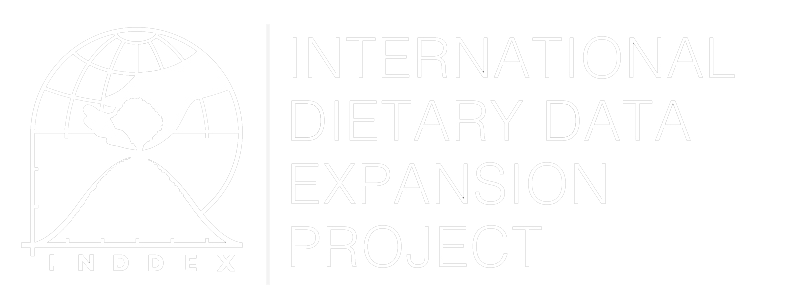Minimum Dietary Diversity (MDD-IYCF) for children 6-23 months old
Overview
The minimum dietary diversity (MDD) score for children 6-23 months old is a population-level indicator to assess diet diversity as part of infant and young child feeding (IYCF) practices. This indicator is part of the suite of complementary feeding indicators for IYCF developed by WHO and UNICEF to provide simple, valid, and reliable metrics for assessing IYCF practices at the population level (WHO/UNICEF, 2021). The MDD is also a component of the Minimum Acceptable Diet (MAD) indicator, which is a composite indicator described in the same 2021 guidelines.
Method of Construction
MDD is measured as a percentage of children 6-23 months of age who consumed foods and beverages from at least five out of eight defined food groups during the previous day (WHO/UNICEF, 2021).
Data are gathered from a questionnaire administered to the child's caregiver, usually as part of the IYCF module. Respondents are asked to indicate whether or not their child consumed any food over the previous 24 hours from each of the eight food groups. The eight food groups included in the questionnaire are:
| 1 | Breast milk |
| 2 | Grains, white/pale starchy roots, tubers and plantains |
| 3 | Beans, peas, lentils, nuts and seeds |
| 4 | Dairy products (milk, infant formula, yogurt, cheese) |
| 5 | Flesh foods ((meat, fish, poultry, organ meats) |
| 6 | Eggs |
| 7 | Vitamin-A rich fruits and vegetables |
| 8 | Other fruits and vegetables |
The total number of food groups consumed is summed. The population-level indicator is calculated based on the following formula:

Please refer to the WHO/UNICEF guidelines for more information on calculating this indicator.
Uses
Minimum dietary diversity has been shown to be positively associated with the mean micronutrient adequacy of the diet (see Steyn et al., 2014). The MDD can be used to monitor and assess the dietary quality of infants and young children and the appropriateness of complementary feeding practices at the population level (WHO/UNICEF, 2021). As a simple and easy-to-interpret indicator, the MDD is appropriate for identifying high-need populations, setting national-level targets, and monitoring and assessing interventions.
The previous version of the MDD indicator guidance (WHO 2008) measured up to 7 food groups and did not capture breastmilk as a food source, thereby 'penalizing' breastfed children in comparison to formula-fed children in assessing their diet quality. The 2021 guidance includes breast milk as one of the 8 food groups, which makes the comparison of MDD for breastfed and non-breastfed infants more accurate. This means, though that indicators calculated using the 'old' method are not comparable to those calculated using the 'new' method (see Roy et al., 2022); and must be recalculated using a single method for the purpose of comparability.
Strengths and Weaknesses
One advantage of the MDD is that it is simple to collect, tabulate, and interpret, and is applicable across sociocultural contexts.
A limitation of the indicator is the lack of information on the type of diets consumed amongst children meeting or not meeting MDD. Since the minimum diet diversity threshold of five food groups can be achieved by consuming with any combination of the eight possible food groupings, the same MDD value amongst children could be due to different dietary combinations (Beckerman-Hsu et. al., 2020).
Data Source
The MDD indicator can be constructed, like other dietary diversity measures, from a standard module administered to the child’s caretaker. Example questionnaires can be found in the WHO/UNICEF, 2021 guidelines. This indicator is also available for many countries in the UNICEF Infant and Young Child Feeding Database and is collected as part of many Demographic and Health Surveys (DHS).
Links to Guidelines
Links to Validation Studies
- Jones et al., (2013). "World Health Organization infant and young child feeding indicators and their associations with child anthropometry: A synthesis of recent findings"
- Moursi, M. M., Arimond, M., Dewey, K. G., Trèche, S., Ruel, M. T., & Delpeuch, F. (2008). Dietary Diversity Is a Good Predictor of the Micronutrient Density of the Diet of 6- to 23-Month-Old Children in Madagascar. The Journal of Nutrition
- Working Group on Infant and Young Child Feeding Indicators. Developing and Validating Simple Indicators of Dietary Quality and Energy Intake of Infants and Young Children in Developing Countries: Summary of findings from analysis of 10 data sets. Report
- Beckerman-Hsu, J. P., Kim, R., Sharma, S., & Subramanian, S. (2020). Dietary Variation among Children Meeting and Not Meeting Minimum Dietary Diversity: An Empirical Investigation of Food Group Consumption Patterns among 73,036 Children in India.
Links to Illustrative Analyses
- United Nations International Children’s Emergency Fund, (2016). "From the first hour of life" Joshi et al., (2011). "Determinants of inappropriate complementary feeding practices in young children in Nepal: Secondary data analysis of Demographic and Heal
- Khamis et al., (2019). The influence of dietary diversity on the nutritional status of children between 6 and 23 months of age in Tanzania. BMC Pediatrics.
- Diop L, Becquey E, Turowska Z, Huybregts L, Ruel MT, Gelli A. (2021) Standard Minimum Dietary Diversity Indicators for Women or Infants and Young Children Are Good Predictors of Adequate Micronutrient Intakes in 24-59-Month-Old Children and Their Nonpregn
- Paramashanti et al., (2022). Trends and determinants of minimum dietary diversity among children aged 6–23 months: a pooled analysis of Indonesia demographic and health surveys from 2007 to 2017. Public Health Nutrition.
